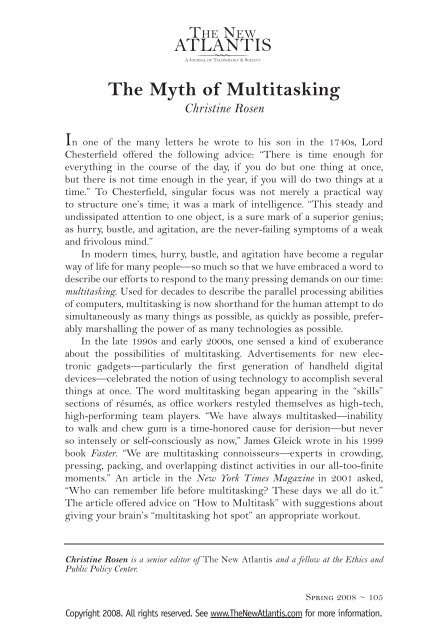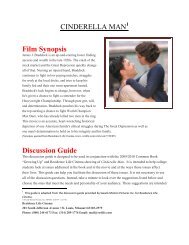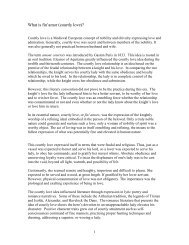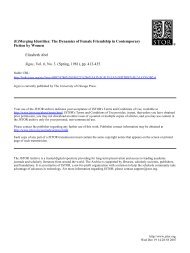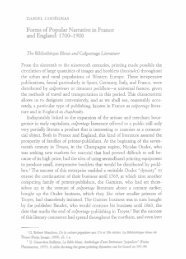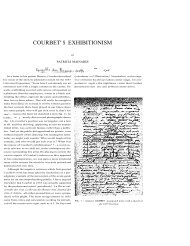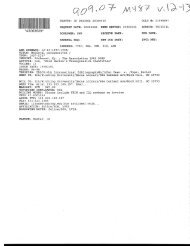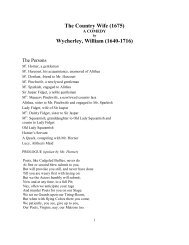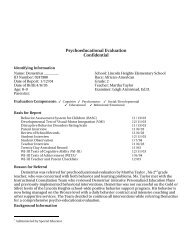The Myth of Multitasking
The Myth of Multitasking
The Myth of Multitasking
Create successful ePaper yourself
Turn your PDF publications into a flip-book with our unique Google optimized e-Paper software.
<strong>The</strong> <strong>Myth</strong> <strong>of</strong> <strong>Multitasking</strong><br />
Christine Rosen<br />
In one <strong>of</strong> the many letters he wrote to his son in the 1740s, Lord<br />
Chesterfield <strong>of</strong>fered the following advice: “<strong>The</strong>re is time enough for<br />
everything in the course <strong>of</strong> the day, if you do but one thing at once,<br />
but there is not time enough in the year, if you will do two things at a<br />
time.” To Chesterfield, singular focus was not merely a practical way<br />
to structure one’s time; it was a mark <strong>of</strong> intelligence. “This steady and<br />
undissipated attention to one object, is a sure mark <strong>of</strong> a superior genius;<br />
as hurry, bustle, and agitation, are the never-failing symptoms <strong>of</strong> a weak<br />
and frivolous mind.”<br />
In modern times, hurry, bustle, and agitation have become a regular<br />
way <strong>of</strong> life for many people—so much so that we have embraced a word to<br />
describe our efforts to respond to the many pressing demands on our time:<br />
multitasking. Used for decades to describe the parallel processing abilities<br />
<strong>of</strong> computers, multitasking is now shorthand for the human attempt to do<br />
simultaneously as many things as possible, as quickly as possible, preferably<br />
marshalling the power <strong>of</strong> as many technologies as possible.<br />
In the late 1990s and early 2000s, one sensed a kind <strong>of</strong> exuberance<br />
about the possibilities <strong>of</strong> multitasking. Advertisements for new electronic<br />
gadgets—particularly the first generation <strong>of</strong> handheld digital<br />
devices—celebrated the notion <strong>of</strong> using technology to accomplish several<br />
things at once. <strong>The</strong> word multitasking began appearing in the “skills”<br />
sections <strong>of</strong> résumés, as <strong>of</strong>fice workers restyled themselves as high-tech,<br />
high-performing team players. “We have always multitasked—inability<br />
to walk and chew gum is a time-honored cause for derision—but never<br />
so intensely or self-consciously as now,” James Gleick wrote in his 1999<br />
book Faster. “We are multitasking connoisseurs—experts in crowding,<br />
pressing, packing, and overlapping distinct activities in our all-too-finite<br />
moments.” An article in the New York Times Magazine in 2001 asked,<br />
“Who can remember life before multitasking? <strong>The</strong>se days we all do it.”<br />
<strong>The</strong> article <strong>of</strong>fered advice on “How to Multitask” with suggestions about<br />
giving your brain’s “multitasking hot spot” an appropriate workout.<br />
Christine Rosen is a senior editor <strong>of</strong> <strong>The</strong> New Atlantis and a fellow at the Ethics and<br />
Public Policy Center.<br />
Spring 2008 ~ 105<br />
Copyright 2008. All rights reserved. See www.<strong>The</strong>NewAtlantis.com for more information.
Christine Rosen<br />
But more recently, challenges to the ethos <strong>of</strong> multitasking have begun<br />
to emerge. Numerous studies have shown the sometimes-fatal danger <strong>of</strong><br />
using cell phones and other electronic devices while driving, for example,<br />
and several states have now made that particular form <strong>of</strong> multitasking<br />
illegal. In the business world, where concerns about time-management<br />
are perennial, warnings about workplace distractions spawned by a multitasking<br />
culture are on the rise. In 2005, the BBC reported on a research<br />
study, funded by Hewlett-Packard and conducted by the Institute <strong>of</strong><br />
Psychiatry at the University <strong>of</strong> London, that found, “Workers distracted<br />
by e-mail and phone calls suffer a fall in IQ more than twice that found in<br />
marijuana smokers.” <strong>The</strong> psychologist who led the study called this new<br />
“infomania” a serious threat to workplace productivity. One <strong>of</strong> the Harvard<br />
Business Review’s “Breakthrough Ideas” for 2007 was Linda Stone’s notion<br />
<strong>of</strong> “continuous partial attention,” which might be understood as a subspecies<br />
<strong>of</strong> multitasking: using mobile computing power and the Internet, we<br />
are “constantly scanning for opportunities and staying on top <strong>of</strong> contacts,<br />
events, and activities in an effort to miss nothing.”<br />
Dr. Edward Hallowell, a Massachusetts-based psychiatrist who specializes<br />
in the treatment <strong>of</strong> attention deficit/hyperactivity disorder and<br />
has written a book with the self-explanatory title CrazyBusy, has been<br />
<strong>of</strong>fering therapies to combat extreme multitasking for years; in his book<br />
he calls multitasking a “mythical activity in which people believe they can<br />
perform two or more tasks simultaneously.” In a 2005 article, he described<br />
a new condition, “Attention Deficit Trait,” which he claims is rampant in<br />
the business world. ADT is “purely a response to the hyperkinetic environment<br />
in which we live,” writes Hallowell, and its hallmark symptoms<br />
mimic those <strong>of</strong> ADD. “Never in history has the human brain been asked<br />
to track so many data points,” Hallowell argues, and this challenge “can<br />
be controlled only by creatively engineering one’s environment and one’s<br />
emotional and physical health.” Limiting multitasking is essential. Bestselling<br />
business advice author Timothy Ferriss also extols the virtues <strong>of</strong><br />
“single-tasking” in his book, <strong>The</strong> 4-Hour Workweek.<br />
<strong>Multitasking</strong> might also be taking a toll on the economy. One study by<br />
researchers at the University <strong>of</strong> California at Irvine monitored interruptions<br />
among <strong>of</strong>fice workers; they found that workers took an average <strong>of</strong> twentyfive<br />
minutes to recover from interruptions such as phone calls or answering<br />
e-mail and return to their original task. Discussing multitasking with<br />
the New York Times in 2007, Jonathan B. Spira, an analyst at the business<br />
research firm Basex, estimated that extreme multitasking—information<br />
overload—costs the U.S. economy $650 billion a year in lost productivity.<br />
106 ~ <strong>The</strong> New Atlantis<br />
Copyright 2008. All rights reserved. See www.<strong>The</strong>NewAtlantis.com for more information.
<strong>The</strong> <strong>Myth</strong> <strong>of</strong> <strong>Multitasking</strong><br />
Changing Our Brains<br />
To better understand the multitasking phenomenon, neurologists and<br />
psychologists have studied the workings <strong>of</strong> the brain. In 1999, Jordan<br />
Grafman, chief <strong>of</strong> cognitive neuroscience at the National Institute <strong>of</strong><br />
Neurological Disorders and Stroke (part <strong>of</strong> the National Institutes <strong>of</strong><br />
Health), used functional magnetic resonance imaging (fMRI) scans to<br />
determine that when people engage in “task-switching”—that is, multitasking<br />
behavior—the flow <strong>of</strong> blood increases to a region <strong>of</strong> the frontal<br />
cortex called Brodmann area 10. (<strong>The</strong> flow <strong>of</strong> blood to particular regions<br />
<strong>of</strong> the brain is taken as a proxy indication <strong>of</strong> activity in those regions.)<br />
“This is presumably the last part <strong>of</strong> the brain to evolve, the most mysterious<br />
and exciting part,” Grafman told the New York Times in 2001—adding,<br />
with a touch <strong>of</strong> hyperbole, “It’s what makes us most human.”<br />
It is also what makes multitasking a poor long-term strategy for<br />
learning. Other studies, such as those performed by psychologist René<br />
Marois <strong>of</strong> Vanderbilt University, have used fMRI to demonstrate the<br />
brain’s response to handling multiple tasks. Marois found evidence <strong>of</strong> a<br />
“response selection bottleneck” that occurs when the brain is forced to<br />
respond to several stimuli at once. As a result, task-switching leads to<br />
time lost as the brain determines which task to perform. Psychologist<br />
David Meyer at the University <strong>of</strong> Michigan believes that rather than a<br />
bottleneck in the brain, a process <strong>of</strong> “adaptive executive control” takes<br />
place, which “schedules task processes appropriately to obey instructions<br />
about their relative priorities and serial order,” as he described to the New<br />
Scientist. Unlike many other researchers who study multitasking, Meyer<br />
is optimistic that, with training, the brain can learn to task-switch more<br />
effectively, and there is some evidence that certain simple tasks are amenable<br />
to such practice. But his research has also found that multitasking<br />
contributes to the release <strong>of</strong> stress hormones and adrenaline, which can<br />
cause long-term health problems if not controlled, and contributes to the<br />
loss <strong>of</strong> short-term memory.<br />
In one recent study, Russell Poldrack, a psychology pr<strong>of</strong>essor at the<br />
University <strong>of</strong> California, Los Angeles, found that “multitasking adversely<br />
affects how you learn. Even if you learn while multitasking, that learning<br />
is less flexible and more specialized, so you cannot retrieve the information<br />
as easily.” His research demonstrates that people use different areas <strong>of</strong> the<br />
brain for learning and storing new information when they are distracted:<br />
brain scans <strong>of</strong> people who are distracted or multitasking show activity in<br />
the striatum, a region <strong>of</strong> the brain involved in learning new skills; brain<br />
Spring 2008 ~ 107<br />
Copyright 2008. All rights reserved. See www.<strong>The</strong>NewAtlantis.com for more information.
Christine Rosen<br />
scans <strong>of</strong> people who are not distracted show activity in the hippocampus,<br />
a region involved in storing and recalling information. Discussing his<br />
research on National Public Radio recently, Poldrack warned, “We have to<br />
be aware that there is a cost to the way that our society is changing, that<br />
humans are not built to work this way. We’re really built to focus. And<br />
when we sort <strong>of</strong> force ourselves to multitask, we’re driving ourselves to<br />
perhaps be less efficient in the long run even though it sometimes feels<br />
like we’re being more efficient.”<br />
If, as Poldrack concluded, “multitasking changes the way people<br />
learn,” what might this mean for today’s children and teens, raised with<br />
an excess <strong>of</strong> new entertainment and educational technology, and avidly<br />
multitasking at a young age? Poldrack calls this the “million-dollar question.”<br />
Media multitasking—that is, the simultaneous use <strong>of</strong> several different<br />
media, such as television, the Internet, video games, text messages,<br />
telephones, and e-mail—is clearly on the rise, as a 2006 report from the<br />
Kaiser Family Foundation showed: in 1999, only 16 percent <strong>of</strong> the time<br />
people spent using any <strong>of</strong> those media was spent on multiple media at<br />
once; by 2005, 26 percent <strong>of</strong> media time was spent multitasking. “I multitask<br />
every single second I am online,” confessed one study participant.<br />
“At this very moment I am watching TV, checking my e-mail every two<br />
minutes, reading a newsgroup about who shot JFK, burning some music<br />
to a CD, and writing this message.”<br />
<strong>The</strong> Kaiser report noted several factors that increase the likelihood <strong>of</strong><br />
media multitasking, including “having a computer and being able to see a<br />
television from it.” Also, “sensation-seeking” personality types are more<br />
likely to multitask, as are those living in “a highly TV-oriented household.”<br />
<strong>The</strong> picture that emerges <strong>of</strong> these pubescent multitasking mavens is <strong>of</strong> a<br />
generation <strong>of</strong> great technical facility and intelligence but <strong>of</strong> extreme impatience,<br />
unsatisfied with slowness and uncomfortable with silence: “I get<br />
bored if it’s not all going at once, because everything has gaps—waiting<br />
for a website to come up, commercials on TV, etc.” one participant said.<br />
<strong>The</strong> report concludes on a very peculiar note, perhaps intended to be optimistic:<br />
“In this media-heavy world, it is likely that brains that are more<br />
adept at media multitasking will be passed along and these changes will be<br />
naturally selected,” the report states. “After all, information is power, and<br />
if one can process more information all at once, perhaps one can be more<br />
powerful.” This is techno-social Darwinism, nature red in pixel and claw.<br />
Other experts aren’t so sure. As neurologist Jordan Grafman told Time<br />
magazine: “Kids that are instant messaging while doing homework, playing<br />
games online and watching TV, I predict, aren’t going to do well in<br />
108 ~ <strong>The</strong> New Atlantis<br />
Copyright 2008. All rights reserved. See www.<strong>The</strong>NewAtlantis.com for more information.
<strong>The</strong> <strong>Myth</strong> <strong>of</strong> <strong>Multitasking</strong><br />
the long run.” “I think this generation <strong>of</strong> kids is guinea pigs,” educational<br />
psychologist Jane Healy told the San Francisco Chronicle; she worries that<br />
they might become adults who engage in “very quick but very shallow<br />
thinking.” Or, as the novelist Walter Kirn suggests in a deft essay in <strong>The</strong><br />
Atlantic, we might be headed for an “Attention-Deficit Recession.”<br />
Paying Attention<br />
When we talk about multitasking, we are really talking about attention:<br />
the art <strong>of</strong> paying attention, the ability to shift our attention, and, more<br />
broadly, to exercise judgment about what objects are worthy <strong>of</strong> our attention.<br />
People who have achieved great things <strong>of</strong>ten credit for their success<br />
a finely honed skill for paying attention. When asked about his particular<br />
genius, Isaac Newton responded that if he had made any discoveries, it<br />
was “owing more to patient attention than to any other talent.”<br />
William James, the great psychologist, wrote at length about the varieties<br />
<strong>of</strong> human attention. In <strong>The</strong> Principles <strong>of</strong> Psychology (1890), he outlined<br />
the differences among “sensorial attention,” “intellectual attention,” “passive<br />
attention,” and the like, and noted the “gray chaotic indiscriminateness”<br />
<strong>of</strong> the minds <strong>of</strong> people who were incapable <strong>of</strong> paying attention. James<br />
compared our stream <strong>of</strong> thought to a river, and his observations presaged<br />
the cognitive “bottlenecks” described later by neurologists: “On the whole<br />
easy simple flowing predominates in it, the drift <strong>of</strong> things is with the pull<br />
<strong>of</strong> gravity, and effortless attention is the rule,” he wrote. “But at intervals<br />
an obstruction, a set-back, a log-jam occurs, stops the current, creates an<br />
eddy, and makes things temporarily move the other way.”<br />
To James, steady attention was thus the default condition <strong>of</strong> a mature<br />
mind, an ordinary state undone only by perturbation. To readers a century<br />
later, that placid portrayal may seem alien—as though depicting a<br />
bygone world. Instead, today’s multitasking adult may find something<br />
more familiar in James’s description <strong>of</strong> the youthful mind: an “extreme<br />
mobility <strong>of</strong> the attention” that “makes the child seem to belong less to<br />
himself than to every object which happens to catch his notice.” For some<br />
people, James noted, this challenge is never overcome; such people only<br />
get their work done “in the interstices <strong>of</strong> their mind-wandering.” Like<br />
Chesterfield, James believed that the transition from youthful distraction<br />
to mature attention was in large part the result <strong>of</strong> personal mastery and<br />
discipline—and so was illustrative <strong>of</strong> character. “<strong>The</strong> faculty <strong>of</strong> voluntarily<br />
bringing back a wandering attention, over and over again,” he wrote,<br />
“is the very root <strong>of</strong> judgment, character, and will.”<br />
Spring 2008 ~ 109<br />
Copyright 2008. All rights reserved. See www.<strong>The</strong>NewAtlantis.com for more information.
Christine Rosen<br />
Today, our collective will to pay attention seems fairly weak. We<br />
require advice books to teach us how to avoid distraction. In the not-toodistant<br />
future we may even employ new devices to help us overcome the<br />
unintended attention deficits created by today’s gadgets. As one New York<br />
Times article recently suggested, “Further research could help create clever<br />
technology, like sensors or smart s<strong>of</strong>tware that workers could instruct<br />
with their preferences and priorities to serve as a high tech ‘time nanny’<br />
to ease the modern multitasker’s plight.” Perhaps we will all accept as a<br />
matter <strong>of</strong> course a computer governor—like the devices placed on engines<br />
so that people can’t drive cars beyond a certain speed. Our technological<br />
governors might prompt us with reminders to set mental limits when we<br />
try to do too much, too quickly, all at once.<br />
<strong>The</strong>n again, perhaps we will simply adjust and come to accept what<br />
James called “acquired inattention.” E-mails pouring in, cell phones ringing,<br />
televisions blaring, podcasts streaming—all this may become background<br />
noise, like the “din <strong>of</strong> a foundry or factory” that James observed<br />
workers could scarcely avoid at first, but which eventually became just<br />
another part <strong>of</strong> their daily routine. For the younger generation <strong>of</strong> multitaskers,<br />
the great electronic din is an expected part <strong>of</strong> everyday life. And<br />
given what neuroscience and anecdotal evidence have shown us, this state<br />
<strong>of</strong> constant intentional self-distraction could well be <strong>of</strong> pr<strong>of</strong>ound detriment<br />
to individual and cultural well-being. When people do their work<br />
only in the “interstices <strong>of</strong> their mind-wandering,” with crumbs <strong>of</strong> attention<br />
rationed out among many competing tasks, their culture may gain in<br />
information, but it will surely weaken in wisdom.<br />
110 ~ <strong>The</strong> New Atlantis<br />
Copyright 2008. All rights reserved. See www.<strong>The</strong>NewAtlantis.com for more information.


